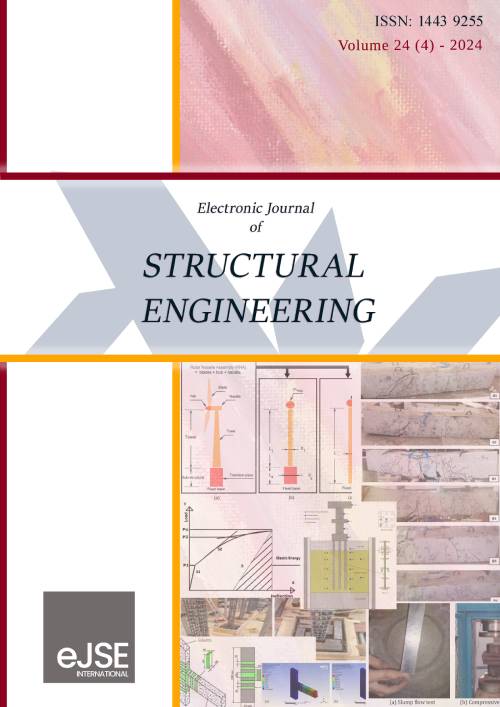Mechanical Properties of High-Volume Fly Ash Mortar Modified by Hybrid Carbon Nano Tube and Graphene Oxide
DOI:
https://doi.org/10.56748/ejse.24659Keywords:
Hybrid, CNT, GO, Mechanical property, Cement mortar, High-volume fly ashAbstract
The effect of combined nano materials on mechanical properties of high-volume fly ash mortar (HVFAM) was carried out in this investigation. The characteristics of HVFAM mixes were first evaluated using slump flow tests. Then, the mechanical properties of HVFAM including the measurement of setting time and the development of early-age compressive strength were performed. Structural changes during hydration were analyzed using FTIR analysis. The study utilized fly ash (FA) as a 60% replacement for cement, with the addition of 0.01% carbon nanotubes (CNT) and graphene oxide (GO) with five different dosages ranging from 0.01% to 0.05%. Results of study showed that the incorporation of hybrid CNT and GO significantly affected the mechanical properties of HVFAM. Specifically, increased of CNT and GO contents lead to significant reduction in both workability and setting time of HVFAM, with a more pronounced reduction in final setting time compared to initial setting time. The development of early-age strength of HVFAM improved by 15.8% with the highest 28 day-strength increasing by approximately 23% at 0.01% CNT and 0.03% GO dosages. FTIR analysis confirmed that the improved early-age strength was attributed to the accelerated hydration of cement caused by the seeding effect. The outcome of the study provides a suitable approach for the development of eco-friendly materials with improved mechanical properties that could be effectively used for HVFAM.
Downloads
References
Adhikary, S. K., Rudžionis, Ž., & Rajapriya, R. (2020). The Effect of Carbon Nanotubes on the Flowability, Mechanical, Microstructural and Durability Properties of Cementitious Composite: An Overview. In Sustainability (Vol. 12, Issue 20). DOI: https://doi.org/10.3390/su12208362
ASTM C618-00. (2001). Standard specification for coal fly ash and raw or calcined natural pozzolan for use in concrete: Annual Book of ASTM Standard. ASTM International, Philadelphia, USA.
Bagheri, A., Negahban, E., Asad, A., Abbasi, H. A., & Raza, S. M. (2022). Graphene oxide-incorporated cementitious composites: a thorough investigation. Materials Advances, 3(24), 9040–9051. DOI: https://doi.org/10.1039/D2MA00169A
Du, M., Jing, H., Gao, Y., Su, H., & Fang, H. (2020). Carbon nanomaterials enhanced cement-based composites: advances and challenges. Nanotechnology Reviews, 9(1), 115–135. DOI: https://doi.org/10.1515/ntrev-2020-0011
Gunasekara, C., Zhou, Z., Sofi, M., Law, D., Setunge, S., & Mendis, P. (2019). Hydration and Strength Evolution of Ternary-Blend High-Volume Fly Ash Concretes. ACI Materials Journal, 116(5), 251–261. DOI: https://doi.org/10.14359/51716815
Huang, C.-H., Lin, S.-K., Chang, C.-S., & Chen, H.-J. (2013). Mix proportions and mechanical properties of concrete containing very high-volume of Class F fly ash. Construction and Building Materials, 46(2013), 71–78. DOI: https://doi.org/10.1016/j.conbuildmat.2013.04.016
Indukuri, C. S. R., Nerella, R., & Madduru, S. R. C. (2020). Workability, microstructure, strength properties and durability properties of graphene oxide reinforced cement paste. Australian Journal of Civil Engineering, 18(1), 73–81. DOI: https://doi.org/10.1080/14488353.2020.1721952
Kaur, R., & Kothiyal, N. C. (2019). Positive synergistic effect of superplasticizer stabilized graphene oxide and functionalized carbon nanotubes as a 3-D hybrid reinforcing phase on the mechanical properties and pore structure refinement of cement nanocomposites. Construction and Building Materials, 222(2019), 358–370. DOI: https://doi.org/10.1016/j.conbuildmat.2019.06.152
Konsta-Gdoutos, M. S., Metaxa, Z. S., & Shah, S. P. (2010). Multi-scale mechanical and fracture characteristics and early-age strain capacity of high-performance carbon nanotube/cement nanocomposites. Cement and Concrete Composites, 32(2), 110–115. DOI: https://doi.org/10.1016/j.cemconcomp.2009.10.007
Lee, H. S., Balasubramanian, B., Gopalakrishna, G. V. T., Kwon, S.-J., Karthick, S. P., & Saraswathy, V. (2018). Durability performance of CNT and nanosilica admixed cement mortar. Construction and Building Materials, 159(2018), 463–472. DOI: https://doi.org/10.1016/j.conbuildmat.2017.11.003
Li, X., Korayem, A. H., Li, C., Liu, Y., He, H., Sanjayan, J. G., & Duan, W. H. (2016). Incorporation of graphene oxide and silica fume into cement paste: A study of dispersion and compressive strength. Construction and Building Materials, 123(2016), 327–335. DOI: https://doi.org/10.1016/j.conbuildmat.2016.07.022
Licht, S., Liu, X., Licht, G., Wang, X., Swesi, A., & Chan, Y. (2019). Amplified CO2 reduction of greenhouse gas emissions with C2CNT carbon nanotube composites. Materials Today Sustainability, 6, 100023. DOI: https://doi.org/10.1016/j.mtsust.2019.100023
Liu, H., Yu, Y., Liu, H., Jin, J., & Liu, S. (2018). Hybrid effects of nano-silica and graphene oxide on mechanical properties and hydration products of oil well cement. Construction and Building Materials, 191(2018), 311–319. DOI: https://doi.org/10.1016/j.conbuildmat.2018.10.029
Makar, J. M., & Chan, G. W. (2009). Growth of cement hydration products on single walled carbon nanotubes. Journal of the American Ceramic Society, 92(6), 1303–1310. DOI: https://doi.org/10.1111/j.1551-2916.2009.03055.x
Miah, M. J., Huaping, R., Paul, S. C., Babafemi, A. J., & Li, Y. (2023). Long-term strength and durability performance of eco-friendly concrete with supplementary cementitious materials. Innovative Infrastructure Solutions, 8(10), 255. DOI: https://doi.org/10.1007/s41062-023-01225-3
Rada, R., Manea, D. L., Chelcea, R., & Rada, S. (2023). Nanocomposites as Substituent of Cement: Structure and Mechanical Properties. In Materials (Vol. 16, Issue 6). DOI: https://doi.org/10.3390/ma16062398
Sanchez, F., & Sobolev, K. (2010). Nanotechnology in concrete–a review. Construction and Building Materials, 24(11), 2060–2071. DOI: https://doi.org/10.1016/j.conbuildmat.2010.03.014
Selim, F. A., Amin, M. S., Ramadan, M., & Hazem, M. M. (2020). Effect of elevated temperature and cooling regimes on the compressive strength, microstructure and radiation attenuation of fly ash–cement composites modified with miscellaneous nanoparticles. Construction and Building Materials, 258(2020), 119648. DOI: https://doi.org/10.1016/j.conbuildmat.2020.119648
Soutsos, M., Hatzitheodorou, A., Kwasny, J., & Kanavaris, F. (2016). Effect of in situ temperature on the early age strength development of concretes with supplementary cementitious materials. Construction and Building Materials, 103(2016), 105–116. DOI: https://doi.org/10.1016/j.conbuildmat.2015.11.034
Sun, C., Chen, L., Xiao, J., Liu, Q., & Zuo, J. (2021). Low-Carbon and Fundamental Properties of Eco-Efficient Mortar with Recycled Powders. In Materials (Vol. 14, Issue 24). DOI: https://doi.org/10.3390/ma14247503
Szostak, B., & Golewski, G. L. (2018). Effect of nano admixture of CSH on selected strength parameters of concrete including fly ash. IOP Conference Series: Materials Science and Engineering, 416(2018), 12105. DOI: https://doi.org/10.1088/1757-899X/416/1/012105
Wang, Q., Li, S., Pan, S., Cui, X., Corr, D. J., & Shah, S. P. (2019). Effect of graphene oxide on the hydration and microstructure of fly ash-cement system. Construction and Building Materials, 198(2019), 106–119. DOI: https://doi.org/10.1016/j.conbuildmat.2018.11.199
Wee, J.-H. (2013). A review on carbon dioxide capture and storage technology using coal fly ash. Applied Energy, 106, 143–151. DOI: https://doi.org/10.1016/j.apenergy.2013.01.062
Zhong, Y. (2023). Insights into the effect of CNTs on cement hydration from the perspective of water evolution. Fullerenes, Nanotubes and Carbon Nanostructures, 31(12), 1123–1131. DOI: https://doi.org/10.1080/1536383X.2023.2254426
Downloads
Published
How to Cite
Issue
Section
License
Copyright (c) 2024 Maizuar Maizuar, Herman Fithra, Khairullah Yusuf, Nura Usrina, Samsul Bahri, Syahrul Fithri Senin

This work is licensed under a Creative Commons Attribution 4.0 International License.







